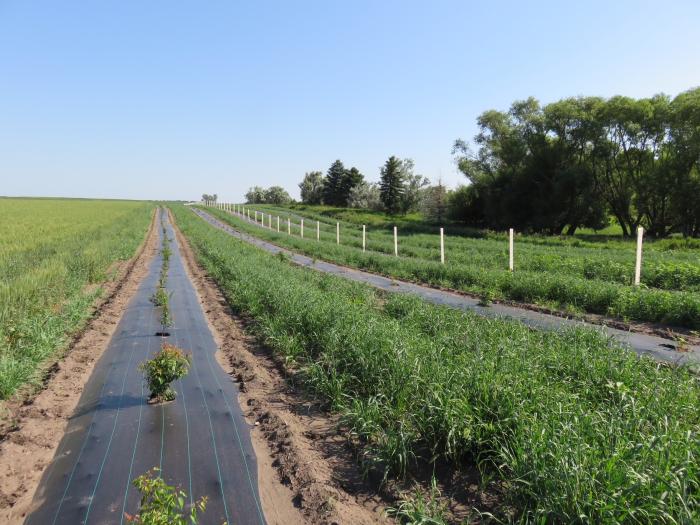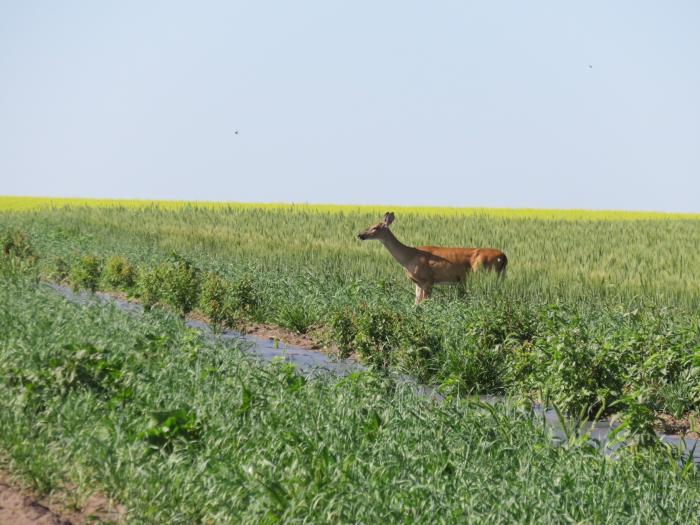Farmers curb soil erosion with shelterbelts
Although his passion is farming, North Dakota Foster County farmer Chad Bickept is one of 13 farmers in that county who will replace and/or plant new shelterbelts this year.
By Loretta Sorensen
Bickept, who raises soybeans, wheat and occasionally corn, recognizes the important role trees play in reducing soil erosion and maintaining the Great Northern Plains wildlife cycle.

“I have some ground that isn’t the best for crops, so I established an l-shaped shelterbelt on it,” Bickept says. “It’s very common these days to see farmers taking shelterbelts out so they can farm a few more acres. But healthy shelterbelts are beneficial to wildlife and important in reducing wind speed and erosion in the kinds of open landscape we have in North Dakota.”
Foster County District Conservationist Paul Dubourt says many of the classic windbreaks established in North Dakota 30 to 40 years ago are dying or dead or may have been removed. However, their importance to the farming community and rural areas are no less important now than they were decades ago.
“I realize, with today’s large equipment, it’s often not easy or convenient to maneuver in small areas or around trees and other elements,” Dubourt says. “But trees are very important in reducing soil erosion by breaking wind speeds in open landscape. Anyone wondering about the effect of wind erosion on farmland can look in their fence line or ditches.”
Silt building up in drainage ditches and/or fence lines are important indicators of soil erosion.
“That silt had to come from somewhere,” Doubourt says. “It’s telling you something about soil and erosion conditions on your land.”
The Natural Resource Conservation Service (NRCS) Environmental Quality Incentives Program (EQIP) offers farmers the opportunity to plant trees on farm land for 10-cents per foot out-of-pocket costs, which means a $1,000 investment would go a long way to either replace an old shelterbelt or establish a new one.
“In Foster County, we’ll plant about 134,000 feet of new trees in 2018,” Doubourt says. “I attribute that to the efforts we’ve made in Foster County to promote the benefits of shelterbelts.”

In helping plan a new shelterbelt, Dubourt’s office assesses a site’s western and northern characteristics to design an appropriate planting.
“The ideal planting is an l-shaped belt that contains at least 3 to 5 rows of trees and bushes that will help break up wind,” Dubourt says. “In our experience, once a farmer explores shelterbelt options and benefits, plantings easily blossom to between five and eight rows of trees and bushes.”
NRCS also has funding sources to help remove shelterbelts. The program, paying approximately .68-cents per foot up to 1,000 feet, covers a significant percentage of having a contractor tear down and remove trees.
While shelterbelt designs have remained very similar over the years, tree varieties more suited to a specific location are now available.
“There’s a bit more science behind both the design and location of today’s shelterbelts,” Dubourt says. “We have approached our townships and county entities to encourage them to take advantage of establishing shelterbelts in areas where they want to stop some snow before its deposited on the road. Keeping it off the roadway saves money.”
Soil testing can help match the most appropriate trees to specific sites. With current planting costs at such an affordable rate, shelterbelts plantings are more attractive to farmers and other rural entities.
On his own farm, Dubourt planted two five-row shelterbelts that were about one-fourth mile long. The trees outline a field perimeter that wasn’t exactly straight, but the trees will help reduce wind erosion.
“Normally wind sweeps across a whole half section before it comes across that field,” Dubourt says. “There’s 10 miles of openness so the wind builds up significant energy, easily drying out the small field.”
Dubourt also appreciates the aesthetic element shelterbelts provide. It takes time for trees and bushes to mature, but the end result is generally very pleasing to the eye.
“Farmers sometimes comment that trees weren’t native to the prairie decades ago,” Dubourt says. “And that’s true. However, with our current cropping practices, with small grains coming off in the fall, soil is often completely bare and barren from September or October through December. That kind of scenario leads to soil erosion and deteriorating soil fertility because the ground was originally covered with native grasses all year.”
Dubourt and Bickept hope farmers in their area will consider maintaining or upgrading shelterbelts to help defend the state against soil erosion and support wildlife.
“I recently saw a fence line picture that looked very much like the 1930s soil erosion we once experienced,” Dubourt says. “Wind erosion isn’t as ever present as it was during that period, but it is still here.”

